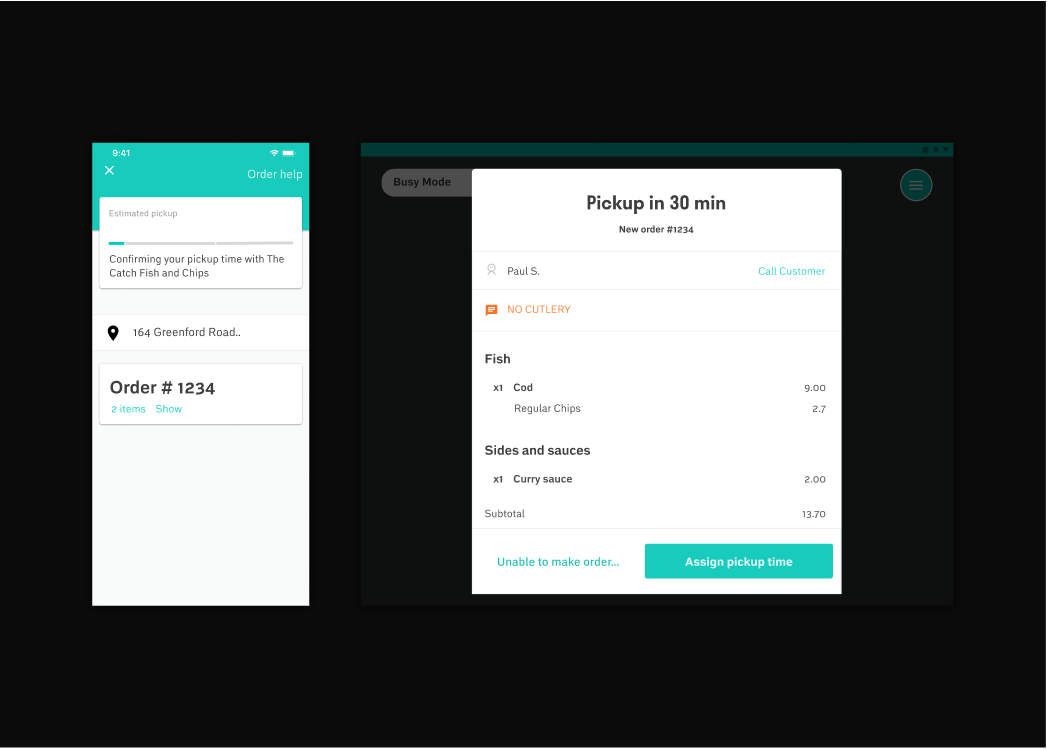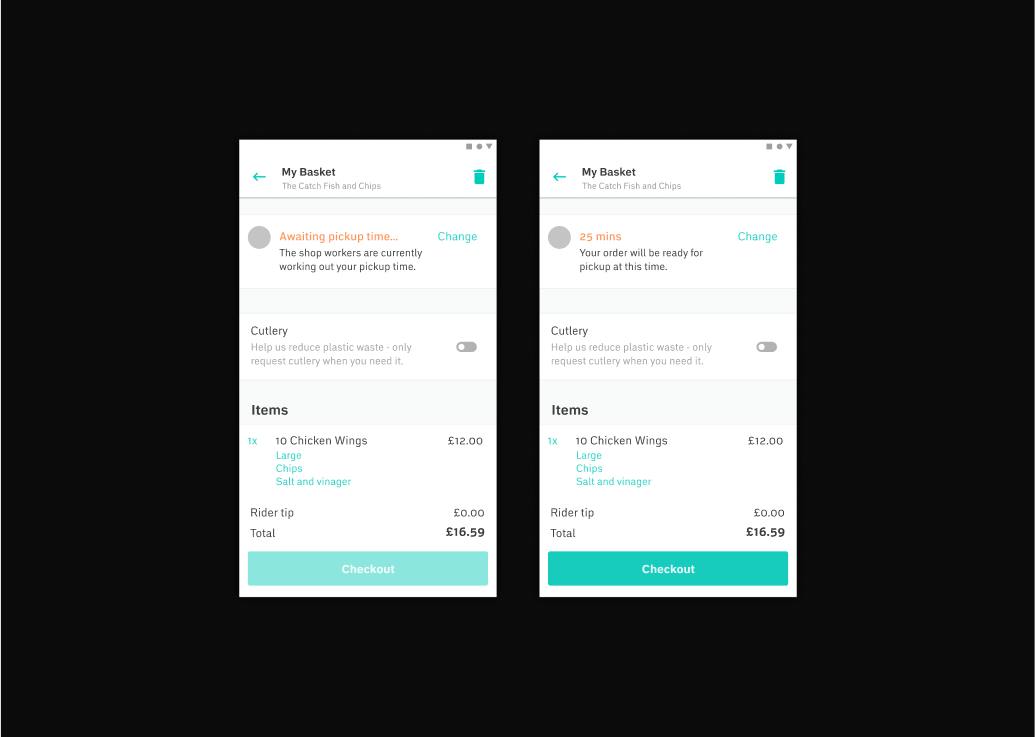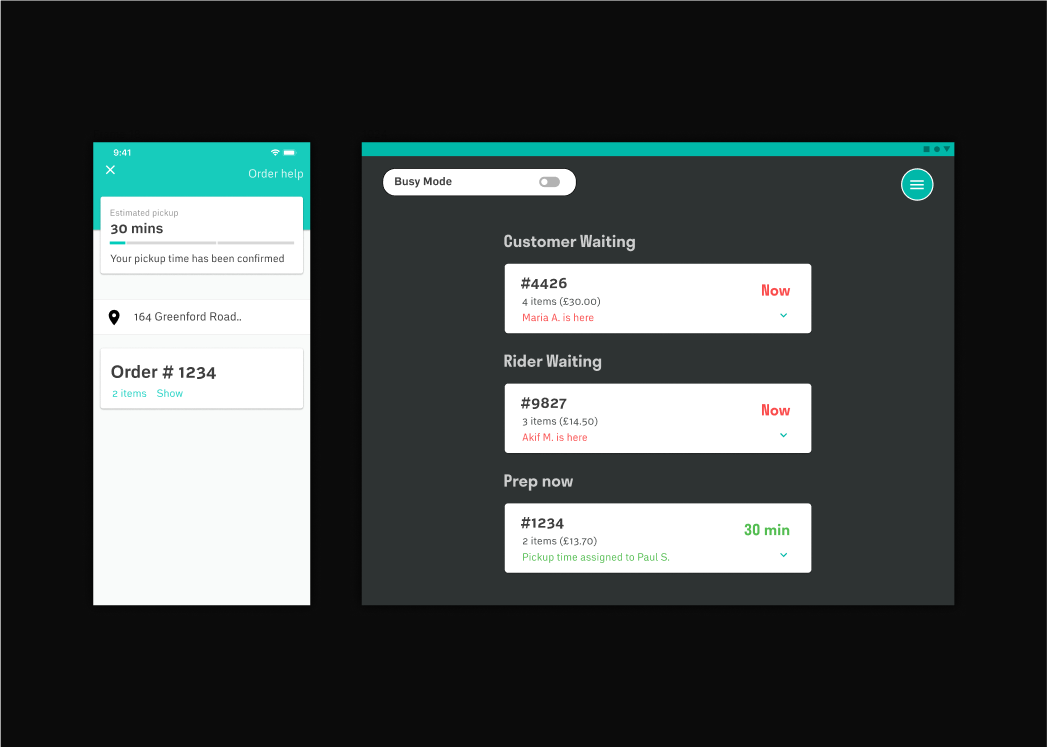A proposal sent to the London Deliveroo team to increase efficiency of order pickup process
PROJECT – PERSONAL PROJECT IN TOUCH WITH DELIVEROO LONDON
ROLE – INTERROGATE USER JOURNEY, DEFINE PAIN POINTS, TEST SOLUTIONS, CREATE MOCK-UPS WITHIN DELIVEROO BRAND.
DATE – 03/11/2020
The context
Due to the current Covid climate, my dad’s fish and chip shop has seen a large increase in takeaway orders. 35% of the order-base is purchasing food via online delivery services. I.e. UberEats, Deliveroo, JustEat. 65% of the order-base are phoning in to order and collect their food. Deliveroo are missing out on this 65%!
FINAL PROTOTYPE SHOWING INTERACTION BETWEEN CUSTOMER AND WORKER
The problem
As phone orders are not process online, problems with efficiency arise. Taking a phone order means that: cash is still being handled when customers pay, food preparation is halted during the call, we can only identify + bag up an order when the customer arrives at their given time slot. We require that P&C customers pay via the Deliveroo app + can be identified before and on collection. Problem statement: server needs to time, prepare and identify a click and collect order without having to halt preparation via a phone call or handle cash on collection.
WE USUSALLY GET A LOT OF WRITTEN PHONE ORDERS WHICH CAN BE DIFFICULT TO MANAGE
Customer’s goals are simple + mimic the needs of our colleagues.
Customer Goals: Order food via Deliveroo as normal, Receive arrival time, Collect food.
Customer tasks: Select click and collect option, Use arrival time and order number to go into shop and collect food.
How do our colleagues feel + behave with the current method of taking phone and collect orders?
- Inconvenienced that taking a customer call will reduce time preparing immediate orders as the call may go on for longer than expected.
- Worried as handling cash will reduce time preparing immediate orders.
- Confused by the potential miscommunication of times and orders from phone and collect customers upon collection. E.g. customer may come late/ give wrong order.
The current flow presents too many opportunities for inefficiency
Main issues were found, such as: the phone being a separate communication device from the Deliveroo tablet (decreasing order efficiency), unnecessary customer questions being asked e.g. Haddock unavailable? which could be answered via tablet, miscommunication via written receipt ( loosing time/money/loyalty), and handling cash (inefficient).
Based on our colleagues and customers needs, the feature should be:
Minimally invasive: a new option as part of the current Deliveroo ordering process, understanding of new user’s goals but accommodating of standard delivery user-group. Reliable: display accurate data and information, clear about any changes in order status. E.g. delay, more efficient at dealing with the above compared to phone call.
Assumptions that will allow me to hone in on our colleagues and customers journey.
We can assume that: Deliveroo and/or our marketing team have communicated to customers that the sole method of ‘click and collect’ is via the Deliveroo app, assigned collection times are accurate based on the shops varying busy periods (our main fryers are accurate most times), Paul has his order number readily available when arrives and is using this feature for the first time.
Why is this feature lucrative for Deliveroo?
This feature An extra 35% cut on a Deliveroo order which would otherwise be lost to a phone call. This phone call benefits neither our shop or your profits. New KPI’s opens the floodgates for a new user-base to be acquired; a silent majority going unnoticed (nearly 65% of takeaway orders).
Are there any constraints that may affect how we move forward?
- Medium: In-shop tablets would need to differentiate between Deliveroo drivers and C&C customers. E.g. their order status, location.
- Funding: as this is a new feature, working towards an MVP would be best in order to start acquiring customers at an early stage.
- At this point I would ask development about design system, could we recycle elements? How much do we need to design for an MVP?
I ran into a problem whilst speaking with my dad further.
The problem: People are phoning in to place and collect their order because it is free (no 49p service charge). So, Uber’s pick-up feature makes up very little of the shops sales. P&C makes up close to 65% of orders + are our most loyal customers. These customers are considered ‘old-school’, so how do we appeal to this user group? Do they use delivery apps at all?
Then it came to me - provide incentive! I suggested to my dad to provide a free small meal for every 10 meals the regulars place via Deliveroo. This would be lucrative for all parties as: a. The 49p charge would pay itself off on the 10th free meal, b. Deliveroo would gain a new user, c. My dad would gain a more loyal customer/ spend more time making money.
The new flow
The new user flow provides these customers and my colleagues with the information they need.
Compromises needed to be made within context of a busy workday
My dad made clear the constraint of not being able to spend too much time at the Deliveroo orders app. Whilst providing a pickup time before the customer pays is closer to the experience of a phone call order, it meant:
- Less integration with the current Deliveroo ordering process.
- Workers were spending more time on the Deliveroo app, seeing if customers had/had not accepted their pickup time.
FIRST ITERATION SHOWS CUSTOMERS PAYING AFTER WE GIVE THEM A PICKUP TIME
The customers new flow
The new flow compromised between the time constraints of the shop and an authentic phone and collect experience.
SELLERS BECAME EASIER TO GUIDE WHEN CONTENT WAS SPLIT OVER MANY PAGES
SECOND ITERATION WHEREBY CUSTOMERS PAY BEFORE
CUSTOMERS STILL EFFICIENTLY RECEIVE A PICKUP TIME WHILST WE CNA FOCUS ON COOKING AND SERVIING
I tested the flow with colleagues and there were areas for improvement.
- Currently we bag up food when the customer arrives. If they are late, we waste time on their order. With this feature, we bag up for assigned pickup time. If late, it's the customers fault and we have reference.
- In the current covid climate, people queue outside, so we have to shout out order and person comes in. With this feature, we can just shout order number. No fuss, time saved.
- 35% Deliveroo cut is too big to bring in our 65% phone customers. If at a lower 20%, my dad is more likely to want to use this feature.
I got in touch with director of design at Deliveroo London and he gave me feedback.
They told me that my ideas and insights were interesting at had great potential. I was so happy to get a response from the team and have my ideas critiqued. It's one of my aims as a product designer, coming from a family-run fish and chip shop, to bring people closer to food and businesses closer to people.
What I learned
Always anticipate a problem before it arises as a crucial misstep -
The user journey map showed that users and business needs had a direct affect on each other. For instance, by considering the CEO’s desire for a mission-driven community, it became clear what kind of copy I needed to use to guide sellers. By the same token, ‘fixing copy’ as a user need brought into focus Reverb’s long term brand image and how this could be affected.
Don’t be afraid to reach out to the top -
By spending a little longer on uncovering areas of exploration through extended research, I was able to more accurately define an MVP over something that is not usable or shippable from the get go.
THAT’S ALL FOR NOW –







